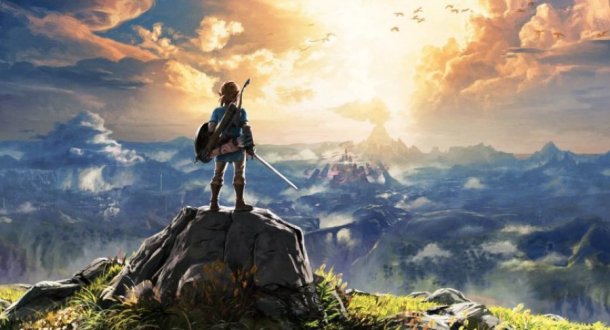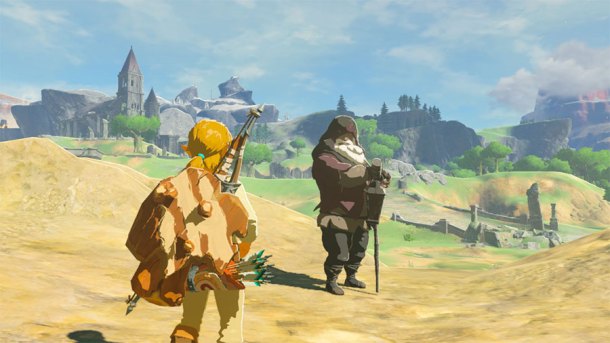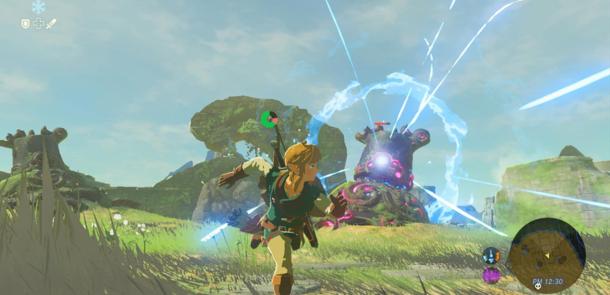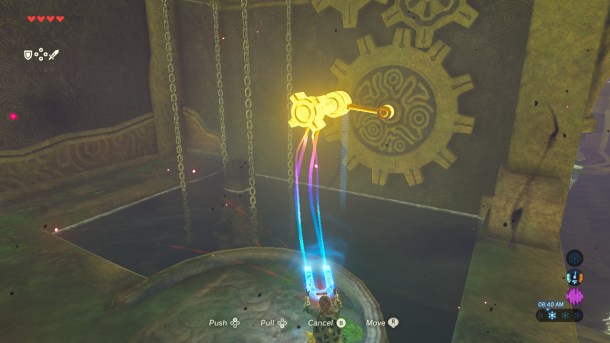 |
|
|---|---|
| Title | The Legend of Zelda: Breath of the Wild |
| Developer | Nintendo |
| Publisher | Nintendo |
| Release Date | March 3rd, 2017 |
| Genre | Adventure |
| Platform | Wii U, Switch |
| Age Rating | E |
| Official Website | |
The long-awaited game has finally launched, and its success has been unprecedented. Breath of the Wild is now playable on Wii U and Switch. But is it really the masterpiece everyone describes? The game had its fair amount of delays, but after all those years, it seems to have become the game that provided the Switch the initial boost it needed, while embodying the pinnacle of Wii U games. Let us see what the game is worth.

Your journey starts in the Shrine of Resurrection, where Link awakes after a sleep of 100 years. A feminine voice calls and you quickly go out of the shrine to discover the wilderness of nature. Those first minutes are enough to sum up the essence of the game. The resurrection of Link is also the resurrection of the Zelda series, as the first thing you will experience while playing is an unprecedented feeling of freedom. Climbing trees, picking apples and setting things on fire are among the numerous possibilities offered to you right from start. This freedom is rather enthralling and is at the extreme opposite of what we could experience in previous Zelda games, where areas were more linear. This freedom also brings new threats, as you have to deal with breakable weapons and shields while facing enemies that can inflict a lot more damage, something that is quite a shock when we have been used to monsters that barely dealt half a heart of damage. You will most likely want to avoid some of them at the beginning, although you could find tricks to weaken them, like bringing different monsters to fight each other, or shooting electric arrows at water.

The concept of breakable items left me with mixed feelings. It forces you to constantly switch weapons and look for new ways to fight, which is an interesting idea. But at the same time, having only breakable items makes achieving goals or quests feel less rewarding. This is a very subjective issue, but I consider a permanent upgrade more rewarding than a good but breakable weapon. I felt like I was missing heroic weapons, what you would call “legendary” or “epic” weapons in other games. Since the hero is the chosen one, it made sense for me that he would have more signature items or weapons that would be part of his identity. On the other hand, all those weapons allow different strategies and more diversity while fighting. For example, two-handed weapons allow you to use a rather destructive spinning move that is very effective against most (if not all) enemies, while the spear’s special move is a series of quick jabs that will stab the enemy.
Using the environment to your advantage is also a possibility that makes sense in this huge open world. The world is lively but also threatened by the wrath of Ganon, and you will quickly find out how and why you must once again defeat the most iconic villain of the series. His presence in the world has impacted the environment and even causes, periodically, the resurrection of deceased monsters. It is important to notice that this time a lot of characters are aware of the threat of Ganon, and will be actively involved in your quest. The artistic design of characters is good and is neither too dark neither too cartoonish. I almost have the feeling that Skyward Sword, Twilight Princess and The Wind Waker were mixed to obtain a more balanced and satisfying result here.

Breath of The Wild wants to emphasize freedom and creativity, and this is also true as far as shrines (the new dungeons of this Zelda) are concerned. Shrines are temples where you have to solve riddles in order to activate a monk statue that will reward you with Spirit Orbs. Once you gather four Spirit Orbs, you can pray to a Goddess Statue in order to get more hearts or more stamina. While you can solve those riddles using the different powers provided by your Sheikah Slate, such as Stasis, the remote bomb, or the freezing water rune, Cryonis, you can also resort to unexpected solutions.
For example, if you do not know how to reach the crate needed to activate a push button, you can drop items from your own inventory. If you don’t know how to cross a pit, you may cause a fire to take advantage of the wind generated by the heat and fly. While all those possibilities are exciting and rewarding, they can’t make me forget an element that is gone from this Zelda; the old model of classic dungeons. Divine Beast dungeons are there to replace the old traditional dungeons, but let us be honest, they are nowhere near as complex as dungeons from previous entries. I was never stuck for a long time in a Divine Beast dungeon, and I am usually average at beating dungeons.

The old puzzle system used in dungeons is probably not compatible with the global philosophy of Breath of The Wild, but I still consider its removal a loss. For some reason, I have the same complaint about the bosses you meet in each dungeon. Somehow, the identity of theses bosses is rather weak, and they don’t retain the charm they often had in previous games. Since the only thing you have to do (generally) is hurt them until they die, there is no specific strategy needed to defeat them. My complaint also targets the design of those bosses. The game is full of interesting monsters like Lynels, Stone Talus and Hinox.
By contrast, it seems the bosses in dungeons lack charisma, and are not as beautiful as other monsters in the game, looking more generic. In the past, beating a boss required you to identify the weakness of the enemy, and use it at your own advantage. In Breath of the Wild, you only need to bring the life of the boss down to zero and killing a boss is not that different from killing a regular foe. I would definitely say that those dungeons are the weakest part of this game. Maybe the developers were so focused on making the open world exciting that they unconsciously neglected the design of these dungeons.

Another important change in this game is how the economy works. You can no longer cut grass to pick up rupees, and most of the time you’ll get money by selling items. This is a convenience needed in an open world where you are bound to buy many more items than you did in previous games, as you will need different armors to deal with environmental hazards, as well as extreme heat or extreme cold. It is a relief to no longer have a limited purse and be able to collect as much money as you want. In previous Zelda games, I cannot remember how many times I felt frustrated with opening a chest full of rupees when my purse was full. The word freedom is synonymous with money as well, apparently.

The management of vast resources also involves collecting food that will help you to heal or get temporary passive bonuses. Cooking is rather intuitive and allows you to mix up to five ingredients, only requiring you find a cooking pot. Some recipes can provide you an important advantage. Being able to recover all your hearts with a single meal is very useful, and raising your attack or defense temporarily can be very important at the beginning of the game, when your weapons are still average. Food can also allow you to resist the elements. Overall, the cooking system is well made and makes the whole experience more addictive.

Another new element of gameplay that completely changes the experience of the game is stamina. Managing stamina is very important if you do not want to drown or fall from a cliff. This is why I would recommend getting about five or six stamina upgrades to make your experience more comfortable.The open world is intended to be dangerous, and stamina contributes to the credibility of the experience.

That freedom is also reflected in the amount of side quests provided by the game. Secondary Quests, Shrine Quests, finding Koroks and completing all shrines is time-consuming and you will spend a lot of hours to do all this. It took me some time to get used to the Sensor+, a function that allows you to spot nearby shrines. It was sometimes irritating to wander around trying to figure where the shrine was, with no other hint than the sound of the Sensor+ to guide me. I would not have been against having another way to help me to trace those shrines, for example with an arrow or an Ariane Thread. But then some would say this goes against the philosophy of the game, which is intended to be less handholding than previous episodes.
Unfortunately, the qualities of the game in the gameplay department do not reflect well in the technical realization. Some graphic effects, like the rain, feel dated, and I experienced performance issues in a few areas of the game, especially areas with snow or when approaching Hyrule Castle. I am aware that the Wii U has some limits, but the game has been developed for so many years that I expected a better optimization. Those issues are far from making the game unplayable, but at times, they can impact the quality of the experience.
I would like to conclude this review on the question of the music in this game. Some players stated that the music was less present than it used to be in previous episodes. I think this is not exactly true. The music is present, but in a different way. The main music is the rhythm of nature and how you flow with it. You will most likely find some subtle references to classic Zelda music while playing, and they are well made, but the main music is the scream of the wind, the regular noise of the rain, the crackling of the fire. This is why music is less present in its traditional form, but this does not make it weaker.

Breath of the Wild is most likely the most ambitious Zelda game from the last two decades. It is not the flawless masterpiece some would like it to be, but it definitely contributes to the much-needed creativity of high budget video games. You will need a lot of time to complete it, (I would say you will need 30 hours to beat the main story if you rush through the game.) but you will certainly spend many more hours to fully enjoy this vast world.
| Review Score | |
|---|---|
| Overall | |
Review copy purchased by the reviewer.




